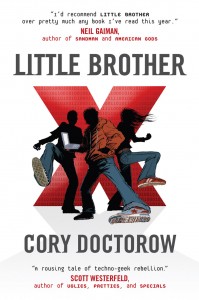Big Trouble in Little Brother
March 6, 2013

The book Little Brother looks at issues of privacy and the power of technology in a seemingly paranoid computer-driven dystopian society where the freedom to move is permitted but constantly monitored. It has gained great popularity and a following that expands well beyond the young adult age group it was initially written for.
Little Brother follows w1n5t0n, more popularly known as Marcus Yallow, a high school student in San Francisco whom, along with a large number of the city’s younger population, has been accused of terrorism, without any factual evidence to back up the charges. Marcus is a computer savvy teen with an extreme talent for hacking computer software. His covert name at Cesar Chavez High is w1n5t0n but no one who knows this will freely share this information. The principal believes he is responsible for stealing information on standardized tests. Unbeknownst to the principal, someone else was actually responsible for this, but that didn’t stop w1n5t0n (those with untrained eyes pronounce it Double-you-one-enn-five-tee-zero-enn) from demanding that the principal show proof.
Marcus’ skills with computers are more than visible as we learn about the many programs he can and is able to override. He has come up with the solution for bypassing the gait-recognition program implemented by the high school to identify students attempting truancy. The program monitors the way students walk and can identify an individual student that happens to walk past an exit. However, besides the fact that some students may change their walking pattern based on their energy level that day, or if they twisted their ankle, Marcus realized that by placing gravel into his shoes, every step would be different thus rendering the gait-recognition program useless. Marcus cracked the Schoolbook, laptops distributed by the school to students as another way of monitoring what sites they are visiting during class, by simply downloading a DVD image into the computer. Marcus also carries a Faraday pouch which neutralizes ID cards and toll-book transponders. To put it simply, Marcus is very aware of how to maintain his privacy. He is always a step ahead of the authorities that watch his every move.
All in all, Marcus is still a kid, and he fancies Alternate Reality Games (ARG’s). ARG’s are games that involve a team that travels through the city exploring its various shops and people, accompanied with a scavenger hunt. The ARG Marcus and his friends play is called Harajuku Fun Madness, the best game ever created, according to Marcus.
One day, Marcus and his three teammates decide to leave their respective schools earlier in the day to get a jumpstart on a new clue just posted on the Harajuku website. They end up in a part of San Francisco rightly named the Tenderloin due to its unique shape. It is here where the story takes a turn for the worst. After a loud boom occurs, the city is in panic, leaving Marcus and his friends fleeing to safety and their futures in jeopardy.
The young adult book Little Brother confronts issues of trust, friendship, identity, love, and bullying, all topics that consume the minds of young adults today. It is perfect for those interested in learning how influential technology is and the ways it can be used as a tool to promote as well as deny freedoms. Finding a novel that presents a relevant and meaningful story with an inclusive plot that appeals to multiple ages can be a challenge. A world where every e-mail sent, every phone call made and every pizza pie purchased is performed under the watchful eye of the big brother in the sky, all for the safety of the American public, is close enough to our own reality that this story strikes a deep, uneasy chord. It also forebodes a future where the inescapable reality of the big brother watching over our every move comes closer to fruition.
Little Brother is endorsed by two prominent young adult novel authors, Neil Gaiman (Sandman) and Scott Westerfeld (The Uglies).






